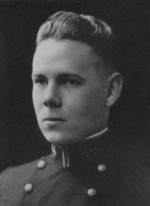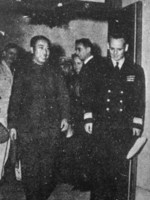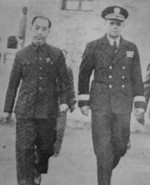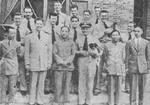Milton Miles
| Surname | Miles |
| Given Name | Milton |
| Born | 6 Apr 1900 |
| Died | 25 Mar 1961 |
| Country | United States |
| Category | Military-Sea |
| Gender | Male |
Contributor: C. Peter Chen
ww2dbaseMilton Edward Robbins was born in 1900 in Jerome, Arizona, United States to sawyer Louis Robbins and Mae Belle Cook. His father passed away in early 1905 when he was not yet five years old. With his mother, he moved to San Bernardino in California then to Seattle in Washington. In early 1910, his mother married George A. Miles, and he took on his stepfather's surname. He graduated Broadway High School in Seattle in 1916. In 1917, five days after the US entrance into WW1, he enlisted in the US Navy. During WW1, he saw service aboard armored cruiser USS Saratoga in the Pacific Ocean and aboard destroyer USS Beale on escort duty in the Atlantic Ocean. In Jun 1918, he enrolled in the US Naval Academy at Annapolis, Maryland, United States by special invitation; he would completed his studies in Jun 1922. During his first year at the naval academy, due to his name's vague similarity with actress Mary Miles Minter, upper classmen gave him the feminine nickname of "Mary", a nickname which would remain with him far beyond graduation. He served with the Asiatic Fleet in China aboard gunboat USS Pecos and four others along the Yangtze River between 1922 and 1927. During this time, he picked up basic Cantonese, Fujianese, Mandarin language skills and learned to appreciate Chinese culture; he particularly showed disdain for westerners who looked down upon the Chinese. He was said to be the first person to have built a short wave radio in China, a machine powered by a motorcycle engine that could communicate as far as Texas in the United States. In 1925, he married Wilma Sinton Jerman in Hong Kong, one day after Jerman arrived from the United States. He was recalled to the United States between 1927 and 1929, during which time he studied at the Naval Postgraduate School at Annapolis and earned a Master's Degree in Electrical Engineering from Columbia University in New York, New York, United States; his wife also earned a Master's Degree in Nutrition Communication from Columbia during the same time period. Between 1929 and 1932, he was an electrical officer aboard aircraft carrier USS Saratoga. Between 1932 and 1934, he served with the Bureau of Engineering of the US Navy. In 1936, he returned to the Asiatic Fleet, spending summer months in Yantai, Shandong Province, China and winter months in Manila, Philippine Islands.
ww2dbaseIn Feb 1939, as the commanding officer of destroyer USS John D. Edwards, Lieutenant Commander Miles arrived at Hainan island in southern China to check up on US missionaries during the Japanese invasion. When his ship approached the Japanese invasion fleet, which was in the process of bombarding Chinese defensive positions along the shore, the Japanese put up pennants requesting his destroyer to keep distance for safety. Miles ignored the recommendation and pushed on, forcing the Japanese to cease firing; while sailing by, he humorously put up a pennant that he had designed as his unofficial personal flag (he had designed it while serving as the executive officer of USS Wilkes some years earlier), consisted of three exclamation points, three question marks, and three asterisks. When he had completed his mission, he paid a courtesy visit to the Japanese admiral in charge of the task force, who asked him about the odd pennant. Miles simply told the Japanese admiral that the admiral's signal book might need updating without further explanation. While Miles might have walked away from this meeting with a chuckle, the admiral took it a bit more seriously. A few months later, after Miles would be transferred back to the United States, he would learn that the Japanese admiral had sent inquiries to the US Navy asking about this pennant so that he could update his signal book.
ww2dbaseIn 1939, Miles was ordered to return to the United States; although they were now the parents of three young boys, one of whom an infant, they decided to have an adventure by hiring a truck to take them across the still under construction Burma Road from Kunming, Yunnan Province, China to Lashio, Burma. Upon returning to the United States, he was attached to the Interior Control Board of the US Navy Department, rising to the position of secretary toward the end of that period. From an unofficial capacity, he had advocated a US Navy presence in China from the perspective of intelligence so that the United States could gain an equivalent understanding of Japanese military technology as the American understanding of German technology, but his recommendations were repeatedly set aside even as political tensions rose between the two countries. In Dec 1941, after the attacking on Pearl Harbor which brought US into WW2, Rear Admiral Willis Lee gave him the assignment to plan the operation Miles had previously recommended. Lee thought Miles himself was the best candidate for this operation as he appreciated Chinese culture, had basic understanding of Mandarin and Fujianese (the latter of which would be especially useful as it was spoken in the coastal Fujian Province), and already had working relationship with the Chinese military such as Chinese Army Colonel Xiao Bo, a military attaché in Washington DC. Through several meetings with Lee and Xiao between Dec 1941 and Mar 1942, the three established the basic goals of such an operation: To monitor weather in China (which was a predictor of Pacific Ocean weather), to recruit coast watchers to monitor Japanese shipping traffic, and to prepare for a possible American invasion three to four years in the future. As his cover, Miles was supposed to report to US Ambassador to China Clarence Gauss as a military attaché, but he was actually to take orders directly from Admiral Ernest King while working alongside of Chinese General Dai Li, who was the head of Chinese Army's Military Bureau of Investigations and Statistics and a close confidant of Chinese President Chiang Kaishek.
ww2dbaseMiles departed from the United States in Apr 1942 and arrived in the Chinese war time capital of Chongqing one month later. En route, he made stops in Brazil; Lagos, Nigeria; Cairo, Egypt; and Karachi, India. While awaiting his flight from Karachi to Chongqing, he made side trips to Mumbai, Colombo, New Delhi, and Kolkata to scout potential supply routes for his future operation as well as meeting with wireless experts to learn more about this technology (he would be required to build and operate his own radio transmitter once he had gotten to China, but he lacked such experience); this caused some alarm with General Dai, who was distrustful of the British, but Dai would quickly learn that Miles' stops in India were not parts of any British anti-Chinese conspiracy. By Jun 1942, he had already gained Dai's trust to the point that he and Dai entered into an agreement for the US Navy to train a 50,000-strong Chinese guerrilla force under the joint-command of both nations. In Aug 1942, while on an official trip to Allahabad, India, he was the target of an ethnic Chinese assassin from Korea, suffering stabbing wounds from a knife; this confirmed that the Japanese was aware of his involvement with General Dai. In Sep 1942, he was assigned to the Office of Special Services (OSS) as the Far East Coordinator, but he would not be informed of this for another month, as it was actually a scheme for OSS to secretly insert agents into China, not necessarily with Miles' knowledge. In late 1942, Miles and Dai began to draw up the specifics of what was to become the Sino-American Special Technical Cooperative Organization, or SACO for short; US Army Chief of Staff George Marshall tried to sabotage this effort due to inter-service rivalry, but his objection would prove to be ineffective in blocking this agreement. As the deputy director of SACO (Dai was officially the director but served more so as an executive sponsor), Miles ran the day-to-day operation, bringing in communications, sabotage, and meteorology experts, among others to conduct actions within their expertise and to train the Chinese. SACO's headquarters was just northwest of Chongqing, on the grounds of Dai's country estate on Gele Mountain; the Americans called the estate "Happy Valley", a play on the meaning of Gele. Describing how he shaped SACO's culture and how he ran the headquarters, Miles said:
ww2dbaseThe main SACO school at "Happy Valley" alone would ultimately graduate 15,000 field-ready guerrilla fighters skilled in demolition, radio interception, photography, hand-to-hand combat, and other areas of expertise. A separate school a mile away, established in Jun 1944, would later turn out Chinese policemen trained by experts from both the US Navy as well as the US Federal Bureau of Investigation. Observation of weather was one of the main reasons why Miles was sent to China; by 1945, SACO had established 70 weather stations in China of various sizes, submitting timely reports used in the planning of Leyte, Iwo Jima, and Okinawa invasions.
ww2dbaseThere were at least three additional known attempts on Miles' life. In Nov 1944, while traveling in a shiny Plymouth Sedan from Kunming to Chongqing, an identified gunman fired into the vehicle, killing his traveling companion but Miles escaped unscathed. In Dec 1944, a Chinese Communist agent undercover as a servant dumped live ammunition into a fire which Dai and Miles were using to keep warm; another servant was able to extinguish the fire before the bullets were set off. Finally, in Jul 1945, at a Chinese Army camp 50 miles south of Shanghai where Dai and Miles were spending the night, Chinese soldiers on guard duty caught three Japanese and one Chinese assassins armed with pistols and grenades attempting to approach their sleeping quarters.
ww2dbaseMiles' personal appreciation for Chinese culture and efforts to integrate American and Chinese servicemen could be seen in the way he ran the administrative offices. For example, he often seated Americans and Chinese staffers alternately, thus promoting conversation, whether through Chinese language, English language, or improvised sign language. In terms of command structure, whenever possible, Miles and Dai would appoint a Chinese deputy to a team if the team lead was an American, and an American deputy if the team lead was Chinese. Entertainer Pat O'Brien, visiting "Happy Valley" for a United Service Organizations (USO) show, noted that Miles' base was the only Asian war-time base he had visited where he was served local cuisine; everywhere else the US servicemen had looked down on the local culture. On a separate topic, O'Brien also noted that "Happy Valley" was the only place where the female entertainers in his troupe did not have to fight off the groping hands of US servicemen.
ww2dbaseIn Nov 1943, after many months of tension, Miles received word from OSS chief William Donovan that he was to be removed from the OSS. In Dec, Donovan personally arrived in Chongqing to fire Miles. The US Navy continued to value Miles' efforts, however, and he retained his position at SACO. In Mar 1945, however, US Army General Albert Wedemeyer gained control over SACO despite Admiral King's protest. Miles remained the commanding officer of US Navy's Naval Group China through the end of the war. In Sep 1945, Navy Naval Group China was disbanded, and his war time rank of rear admiral was reverted to his permanent rank of captain.
ww2dbaseDai passed away in a plane crash in Mar 1946. When Miles heard of the news, he made plans to attend the funeral of his war-time partner, but the trip was denied by George Marshall, who was attempting to court the Chinese Communists, and feared that a US military representative attending a Nationalist leader's funeral would undermine his efforts. He finally found a chance to pay his respects to Dai in 1947 when, as the commanding officer of USS Columbia, he donned civilian clothes and traveled to Nanjing to attend Dai's final burial.
ww2dbaseLater in 1947, Miles was assigned to the staff of the Service Force of the Atlantic Fleet. In 1948, he was promoted to the rank of rear admiral to command Cruiser Division 1. In 1949, he successively commanded Cruiser Division 6 and then Cruiser Division 4. Between 1950 and 1954, he served as the Director of Pan-American Affairs and US Naval Missions in the Office of the Chief of Naval Operations and Senior Naval Delegate to Inter-American Defense Board. In 1954, he served as the Commandant of the 15th Naval District based in Balboa, Panama Canal Zone. In 1955, he briefly served in Tampico, Mexico as the commander of Operation Friendship, a post-Hurricane Janet flood relief operation. Between 1956 and 1958, he was the Commandant of the 3rd Naval District and commanding officer of US Naval Base New York on the east coast of the United States. He retired in 1958 at the rank of vice admiral. In 1960, for his 60th birthday, Chiang Kaishek sent him a scroll of calligraphy which read "Two men in the same boat help each other". Miles passed away of cancer at the National Naval Medical Center in Bethesda, Maryland, United States in Mar 1961.
ww2dbaseSources:
Linda Kush, Rice Paddy Navy
Wikipedia
Last Major Revision: Jun 2015
Milton Miles Interactive Map
Photographs
 |  |  |  |
Milton Miles Timeline
| 6 Apr 1900 | Milton Robbins was born in Jerome, Arizona, United States. |
| 11 Apr 1917 | Milton Miles enlisted in the United States Navy. |
| 3 Jun 1922 | Milton Miles was promoted to the rank of ensign. |
| 3 Jun 1925 | Milton Miles was promoted to the rank of lieutenant (junior grade). |
| 4 Sep 1925 | Milton Miles married Wilma Sinton Jerman in Hong Kong, one day after Jerman arrived from the United States. |
| 3 Jun 1928 | Milton Miles was promoted to the rank of lieutenant. |
| 30 Jun 1937 | Milton Miles was promoted to the rank of lieutenant commander. |
| 1 Jan 1942 | Milton Miles was promoted to the rank of commander. |
| 5 Apr 1942 | Milton Miles departed LaGuardia Marine Terminal, Queens, New York, United States by flying boat. |
| 13 Apr 1942 | Milton Miles arrived in Brazil. |
| 4 May 1942 | Milton Miles arrived in Chongqing, China. |
| 26 May 1942 | Milton Miles and his group departed Chongqing, China by trucks toward the coast. |
| 9 Jun 1942 | At Pucheng, Fujian Province, China, US Navy Commander Milton Miles and Chinese Army Dai Li agreed to form a 50,000-strong US Navy-trained Chinese guerrilla force. Having learned that General Dai was present at Pucheng, the Japanese launched four air raids, slightly injuring Miles. |
| 21 Jun 1942 | Milton Miles was promoted to the war time rank of captain. |
| 21 Sep 1942 | US Navy Admiral William Purnell, after speaking with OSS chief William Donovan, made Milton Miles the head of OSS operations in China. Miles, however, was not informed of this. |
| 12 Oct 1942 | While in China, Milton Miles received a cable from Washington DC, United States informing him of his assignment to the OSS. The cable contained very little detail on what this assignment entailed. |
| 16 Apr 1943 | The Sino-American Special Technical Cooperative Organization, or SACO for short, was officially signed by Captain Milton Miles and General William Donovan for the United States and by Foreign Minister Song Ziwen (also known as T. V. Soong) and Colonel Xiao Bo for China. |
| 4 Jul 1943 | The Sino-American Special Technical Cooperative Organization, or SACO for short, already officially signed into effect in Apr 1943, was signed by Chinese Army General Dai Li in China; Dai had not been able to travel to the United States for the official signing. |
| 9 Nov 1943 | While in China, Milton Miles received a cable from William Donovan informing him that Miles was to be removed from his position in the OSS. |
| 6 Dec 1943 | Milton Miles was fired from the OSS by William Donovan in person in Chongqing, China. |
| 22 Mar 1944 | While in China, Milton Miles was promoted to the war time rank of rear admiral (lower half), thus becoming the highest ranked US Navy officer in China. |
| 20 Sep 1944 | From his headquarters in Chongqing, China, Milton Miles sent SACO's first comprehensive weather map to US Navy Pacific Fleet Command. These reports would continue daily until the end of the war for the planning of Leyte, Iwo Jima, and Okinawa invasions. |
| 7 Oct 1944 | From his headquarters in Chongqing, China, Milton Miles sent US Navy Pacific Fleet Command a daily weather map of China; for the first time, the map covered the entire Chinese coast and 500 miles out into the sea. |
| 4 Sep 1945 | Milton Miles arrived in Shanghai, China by aircraft to prepared for the arrival of the US Navy 7th Fleet. |
| 16 Sep 1945 | In Shanghai, China, after being overworked, recovering from malaria (and at times overdosing on Atabrine), and taking too much Benzedrine and sleeping pills to help him work and rest, Milton Miles began showing signs of psychosis. On this date, he met with newly arrived Thomas Kinkaid in Shanghai, China; Kinkaid described Miles as suffering from "war shock". |
| 21 Sep 1945 | Milton Miles arrived at his headquarters in Chongqing, China. |
| 22 Sep 1945 | The overworked Milton Miles was placed under house arrest at his headquarters in Chongqing, China by the orders of his physician. |
| 25 Sep 1945 | Milton Miles was awarded the Order of the White Cloud and Golden Banner of the Republic of China while he was at his headquarters in Chongqing, China. |
| 29 Sep 1945 | Milton Miles departed Chongqing, China. Irwin Beyerly would take over command of US Navy's Sino-American Special Technical Cooperative Organization (SACO) organization from Beyerly's headquarters in Shanghai, China. |
| 30 Sep 1945 | Milton Miles was officially relieved of his command of the US Navy Naval Group China, and his rank was reverted to the peace time rank of captain. |
| 25 Mar 1961 | Milton Miles passed away of cancer at the National Naval Medical Center in Maryland, United States. |
Please consider supporting us on Patreon. Even $1 per month will go a long way! Thank you. Please help us spread the word: Stay updated with WW2DB: |
Visitor Submitted Comments
All visitor submitted comments are opinions of those making the submissions and do not reflect views of WW2DB.
» Saratoga
Document(s):
» Press Release on SACO in China During World War II
Related Books:
» The Rice Paddy Navy: U.S. Sailors Undercover in China
- » 1,167 biographies
- » 337 events
- » 44,601 timeline entries
- » 1,243 ships
- » 350 aircraft models
- » 207 vehicle models
- » 376 weapon models
- » 123 historical documents
- » 261 facilities
- » 470 book reviews
- » 28,520 photos
- » 367 maps
James Forrestal, Secretary of the Navy, 23 Feb 1945
Please consider supporting us on Patreon. Even $1 a month will go a long way. Thank you!
Or, please support us by purchasing some WW2DB merchandise at TeeSpring, Thank you!
29 Aug 2021 12:44:50 PM
Great post. As historian for SACO, thanks for promoting what the SACO Vets did for shortening the war and keeping almost five divisions of Japanese in China and not be able to go fight in the Pacific islands. (saconavy.net)